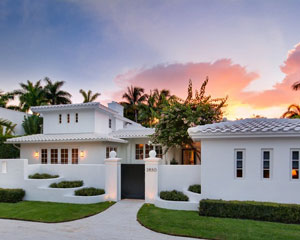Even before the Great Recession ended, some condos at the tip of South Beach towering over Government Cut and South Point Park were selling for stratospheric prices that matched the steepness of their perches. And in the ensuing years, prices for condos anywhere near the water have been climbing nonstop.
But while a 180-degree view of the Atlantic Ocean, the bay and the City of Miami from the 54th floor is great, it doesn’t mean much to a 3-year-old. Over the past few years developers have begun building multi-million dollar spec homes in Miami Beach that are designed for families to live in part-time or for permanent residence.
Many such houses have been built on South Beach’s Star Island, the Venetian Islands and along North Bay Road. Long home to the singing brothers Gibb, North Bay Road has in recent years drawn other celebrities such as Matt Damon, Ricky Martin and Jennifer Lopez, who earlier this year sold her 5800 Bay Road casa to Phil Collins for $33 million.
Longtime New York developer Peter Fine, who is a part-time resident of Miami Beach, has specialized in North Bay Road home construction. His company, To Better Days Development, is building two houses on North Bay Road and designing two more. Earlier this year he listed a 15,000-square-foot mansion at 6440 North Bay Road for $30.5 million. Fine’s homes typically sprawl at least 10,000 square feet with 110 feet of waterfront. “There’s no better place to live than on North Bay Road,” he said. “It’s like living on the ocean … The Bee Gees seemed to like it, Pablo Escobar seemed to like it and I like it.”
For several years other local developers like Todd Glaser, Bart Reines and Shlomy and Oren Alexander have also been building new single-family homes on spec in the 3,000- to 5,000-square-foot range in the Mid-Beach neighborhoods of Sunset Islands, La Gorce and Nautilus.
Quite a few of these new homes are rising not along the waterfront but on Mid-Beach streets, where middle-class neighbors complain that the massive structures seem way out of scale with nearby structures. Preservationists decry the demolition of what they consider to be architecturally significant mid-20th-century homes and instead call for renovating them to accommodate contemporary lifestyles.
After Miami Beach resident Raelene Mercer learned of plans to demolish a 13,681-square-foot 1920s Star Island home, she sprang into action. She and several friends met with city officials to request heightened enforcement of the city’s zoning code, which requires new construction to be “compatible with the established neighborhood context.” A graphic designer, Mercer created striking yard signs calling for the protection of old homes; the placards have now sprouted across Miami Beach. She and her neighbors promote a preservation website, Savemiamibeach.org, and a related Facebook page.
But the city’s regulations provide preservationists only so much ammunition. The city’s Historic Preservation Board can designate houses as “historic” (because of the architect or events that happened there) and this largely prevents their demolition. But houses built before 1942 that are not considered “historic” but deemed “architecturally significant” fall under the purview of the city’s Design Review Board, which can’t halt their removal but can insist that owners examine ways to save them.

In 2014 the Miami Beach City Commission overhauled the regulations for the construction of single-family homes, setting the maximum amount a lot can be covered by a structure at 30 percent and limiting the “unit size” (or size of the home compared with that of its lot) to 50 percent from a previous 70 percent.
Preservationists welcomed these restrictions but wanted to increase required front and side setbacks of new homes, claiming these have a visual impact on a neighborhood.
They are alarmed that 76 applications for the demolition of single-family homes on Miami Beach have been filed since 2014.
With that in mind, City Commissioner Joy Malakoff has proposed a new ordinance that would reduce maximum lot coverage from 30 percent to 25 percent in all single-family districts. It would also limit the maximum unit size of a lot from 50 to 45 percent. Malakoff said lots smaller than 10,500 square feet could be exempt from the new ordinance.
The Malakoff ordinance would increase front setbacks from 20 to 30 feet for two-story homes but for the most part permit 20-foot setbacks for one-story residences. Side setbacks would be boosted from 7.5 feet to 10 feet for many properties. Malakoff said more green space is needed in Miami Beach to mitigate rising sea levels and build in resilience and the setbacks accomplish that.
Front and side setbacks have an immediate effect on neighborhoods, including hers, she claimed. “Across the street from me are two brand-new, beautiful, very expensive homes being built and they are so close together,” she said. “You would think if someone is going to spend millions and millions of dollars for a new home, they’d like privacy and landscaping.”
In early September the city’s Land Use Committee, which Malakoff happens to chair, passed her ordinance before a packed and contentious meeting. Supporters and opponents squared off against one another in a manner reminiscent of the Miami Beach development battles of the 1980s and ’90s. The city commission is expected to hear the measure in October and could pass it to the planning board, whose approval is required before the commission would consider voting on the ordinance. The process could play out for several months.
Daniel Ciraldo of the Miami Design Preservation League said the ordinance could save some older homes on larger lots. “It reduces the incentive to demolish the older homes just for pure profit because you are not going to get as big a home,” he said. “It also ensures that even if homes are demolished, the new homes are a little more in scale in terms of an established neighborhood context.”
Developer Peter Fine allowed that he has some sympathy with preservationists, noting that he “doesn’t like ugly” architecture. Yet he suggested that the current anti-development movement in Miami Beach amounted to “the same old NIMBY just dressed up in a different language.”
Fine said the new proposal raises questions about what might happen next. “Anytime there is political uncertainty, whether because of a change in leadership or because the government keeps changing the rules, it’s not good for investment because you don’t know what the rules are and if the rules are going to change after you had made an investment,” he said.
Todd Glaser, a developer who has been restoring and building homes on Miami Beach for 25 years, said if the new ordinance is approved it could affect 13 homes he is now building or plans to construct. Glaser has restored more than 30 Mediterranean-style homes on Miami Beach, including the home of the city’s founder, Carl Fisher, at 5020 North Bay Road, he said.
In recent years Glaser has specialized in building modern homes — a style he claimed most buyers desire. “They are beautiful, glass, vibrant homes,” he said. “You wake up in the morning and you feel invigorated .”
Glaser said he is following market demands. “If the market wants modern, I will build modern. If the market wants Mediterranean, I’ll build Mediterranean,” he declared.
Preservationists’ fears that old classic homes will be lost are overblown, Glaser said, noting that many of the early 20th-century grand Mediterranean-style homes in Miami Beach, which were built on relatively high grades, are too expensive for developers to buy and replace. The homes being torn down in exchange for new ones were built in the 1940s, ’50s and ’60s; they were constructed cheaply and are in danger of flooding, Glaser asserted.
For her part, Commissioner Malakoff insisted that her new ordinance is limited in scope and designed to maintain privacy, keep neighborhood architecture in scale and sustain green space, which she said is vital for preserving Miami Beach.
“A lot of the homes are going to be around for the next 40 or 50 years,” she said. “What we are doing to keep the streets dry and to fight every type of flooding is going to pay off greatly in the investments of our homes.”
Yet Malakoff opposes designating entire neighborhoods as historic. Many old homes on Miami Beach should not even be preserved, she said. “Some of them have rusted rebar. Some of them were built with beach sand and some have not been maintained and they have deteriorated.”
Miami real estate broker Nancy Batchelor agreed with the notion of refraining from saving structures that don’t warrant it and objected to what she called the “remuddling” of some older homes that have been partially or shoddily restored for a quick sale.
“There are plenty of old houses that have been remodeled so many times they should be knocked down,” she said, adding that others by classic architects should be saved.
Batchelor recently sold just such a home, a 3,643-square-foot residence designed in 1936 by noted architect Carlos Schoepple in Sunset Islands in South Beach. The price of $4.7 million, or $1,292 per square foot, for 2830 Lucerne Avenue set a record for a home not on the waterfront.
“Good design is good design,” she said, “like a classic blue blazer or a black Chanel dress; it never goes out of style.”
Michael Raynes, the developer behind R Investors, which bought and remodeled the Sunset Islands home, said there is a strong demand for well–renovated historic homes that “are brought up to speed to modern standards.”
Raynes, who has renovated and sold several old homes in the Mid-Beach area, said Miami Beach is now attracting sophisticated international buyers who are interested in great art, design and architecture — the sort of individuals who flock to the city for Art Basel in December. Such buyers are looking for “architecturally significant homes that provide modern living within a home that is well designed from the ’30s, ’40s and midcentury.”
Inside her lush mid-Beach garden, Mercer tends a fragile gardenia that she rescued along with other plants from the grounds of an old Prairie Avenue home demolished this past summer. When the house disappeared, away went several royal palms and four gumbo limbos that Mercer estimated were about 80 or 90 years old.
Not only are old homes being lost but with them has vanished nearly a century of biodiversity — and the richness that’s made mid-Miami Beach a tropical paradise, Mercer said.
“Why move here if you are just going to pave it?” she asked. “The whole reason to move here is to live in the tropical oasis that surrounds you.”
For his part, Peter Fine said he, too, cares about Miami Beach’s verdant landscapes. After all, he calls his homes “contemporary tropical.”
Miami Beach is “an urban mix of young, old, working class and wealthy from all over the world where the sun shines 12 months a year,” Fine said. The opposition to the new homes is not about preservation, he asserted, but rather the expression of “people who just don’t want change; they are afraid of change.”




